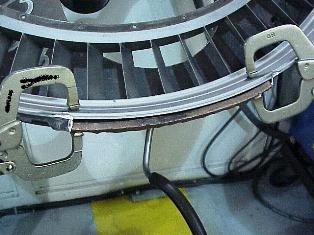Welding Metallurgy of Stainless Steels

Welding Stainless Steel Welcome to Day 2 of your crash course on down and dirty metallurgy.
Stainless steels.
What makes stainless steels stainless ? Stainless steels usually refer to alloys that are mostly iron but also contain some combination of chromium and nickel. For example , the spoon you used this morning to put sugar in your coffee is made from a 300 series stainless steel… Most likely 304 stainless. 304 stainless is also known as an 18/8 stainless meaning is has roughly 18 % chromium, and 8% nickel, and the rest is iron. 300 series stainless steels are all similar in how heat affects them. (With a few exceptions).
There are several things that you need to know about welding 300 series stainless steels: The first thing is Heating and quenching will not harden it. You can take a piece of 300 series stainless steel and get it smoking red hot and then dunk it in ice water and it will not harden. That is a good thing to know because if you are welding in a production environment, you don’t need to be worried about speed cooling 300 series stainless parts. Second thing is that getting it too hot and keeping it hot is bad. When 300 series stainless gets above 900 f, things begin to happen in the microstructure that can cause loss of the stainless properties later on when the part is in service. That is why they make the stabilized grades 321 and 347 stainless steels. They both contain elements that are supposed to prevent this sensitization from happening. Its wise to try to keep the heat down in the first place so that the stainless properties remain intact. 300 series stainless steels take less heat and amperage to weld because they are less conductive than carbon steels. Heat builds up in one place pretty quickly. The third thing is that 300 series stainless can be magnetic if it is cold worked enough. I am telling you this because 90 percent of all welders think that stainless is not magnetic. If you want to prove the point, get a stainless welding rod, a strong magnet, and a hammer and pound on the welding rod until it is good and flat. Now try the magnet. It will be noticeably magnetic in the area that you just cold worked it. A ready made example is 301 stainless ¼ hard or full hard is very strongly magnetic because of the cold working.
Here are some useful things to know about the most common stainless steels:
301 stainless steel is similar to 304 but has a lot more manganese and that allows it to be work hardened to a pretty high hardness. Welding will actually soften a zone in 301 full hard stainless
304 stainless is by far the most commonly used stainless steel, especially in the food and beverage industry and is typically welded with 308L rod.
Stainless steel requires shielding gas coverage if you are making a full penetration weld where the back side of the weld is molten. Failure to shield the back side will result in granulation commonly called sugaring.
309 welding rods are mostly used to weld 300 series to carbon steel. They are very handy to have around because they make really pretty welds on carbon steel also and prevent porosity when welding hot rolled steel.
321 and 347 stainless is very similar in weldability to 304. the main difference is a small amount of titanium, columbium, or tantalum. These elements help maintain corrosion resistance by tying up carbon.
410 stainless will harden by heating and then quenching and needs a stress relieve heat treatment after welding to restore ductility. 410 and other 400 series stainless steels are used for exhaust pipes on automobiles. They can be welded with 309 or 308 rods to avoid the weld hardening.
316L is generally more corrosion resistant than other 300 series stainless steels.
17-4, 17-7, 15-5, and 15-7 stainless steels are hardenable but not from heating and quenching. The way they harden is by aging in a heat treatment for several hours at an elevated temperature. Welding actually may soften a zone in these metals.
Using a carbon steel brush will cause rust on stainless steel. Don’t do it. Getting it too hot and keeping it hot for too long will cause 300 series stainless steels to lose corrosion resistance. Let it cool between passes.
If you have to weld some stainless and have no idea what kind it is (and its not a critical weld that will hurt someone if it fails), 309 stainless, hastelloy W, and inconel 625 filler metal are good choices Bored with Welding Metallurgy?
Custom Search
















